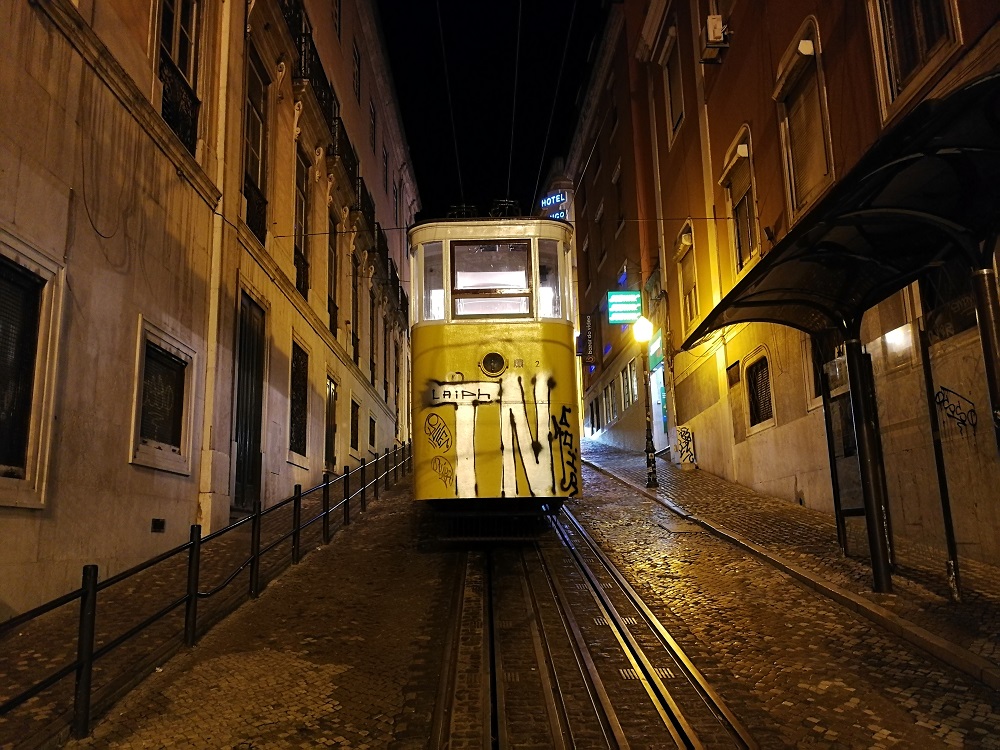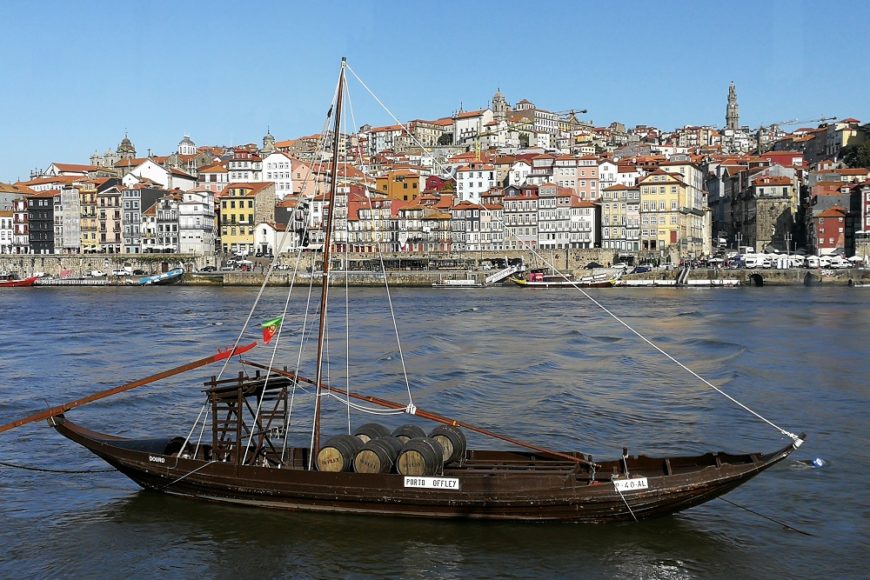
The Best Things I Ate and Drank in Portugal
To be completely honest, Portugal was not on my travel radar. The Side Dish suggested that we go to Spain for our honeymoon, but when we realized that Portugal would stretch our dollar even further we started fantasizing about this mysterious country with its painted tiles and rugged coastline. Since this was our honeymoon it was decidedly not culinary tourism, but I tried to sample as much Portuguese food as possible.
We covered a lot of ground: Porto, Sintra, Lisbon, Evora and driving along the Algarve coast. We did a little stint in Seville, Spain but found ourselves longing to be back in Portugal! The people are friendly, the wine is cheap, and the food is amazing! The Side Dish and I might have different interests (me: food, her: design & performance arts) but we are kindred spirits, thirsty for adventure and wanting to see it all! (We suspect that we may have honeymooned “wrong”, as this was not the most relaxing trip, but we wouldn’t change a thing).
Our honeymoon may have been a sampler basket, but we have completely fallen in love with Portugal and we are already planning out next trip.
Well, it doesn’t look like most of us are going to be planning international trips for a while, but we can always dream, right? In the spirit of pandemic armchair travel, here is a reminiscence of the flavour experiences that made me fall in love with Portugal and Portuguese food.
Porto Tónico
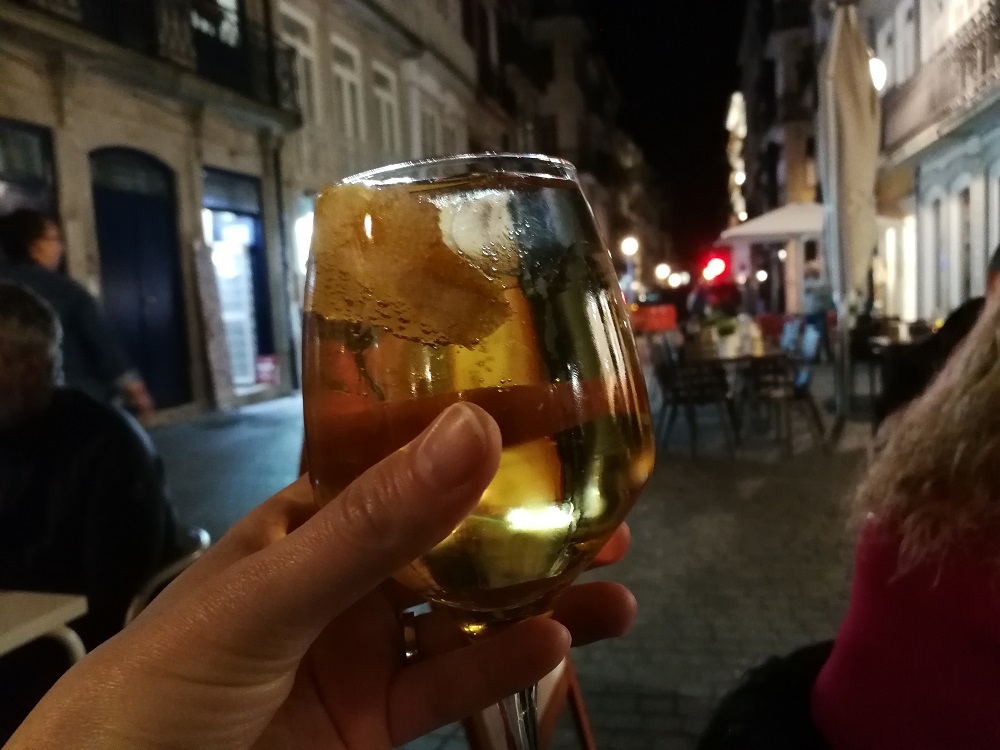
We flew into Porto and took in the beauty (and the wine) for a couple of days, meandering around the Ribeira with its narrow cobbled streets and Douro River views. I quickly discovered this refreshing drink of white port and tonic with a citrus wedge and it is my new favourite thing.
Francesinha Sandwiches

Francesinha Sandwich at Cafe Santiago in Porto
The signature sandwich of Porto is the francesinha, which means “Frenchie” in Portuguese and was invented as an adaptation of the croque-monsieur using Portuguese ingredients. Inside the bread are layers of ham, linguiça (smoke-cured pork sausage with garlic and paprika), fresh sausage, and thinly sliced steak. The sandwich is draped in cheese, and ladled with a spiced tomato and beer sauce. You can get a fried egg on top if you want. It’s common practice to order a side of fries with additional sauce. You should probably drink a beer with it, too.
Café Santiago recently made Big Seven Travel‘s 50 Best Sandwiches in the World. I don’t know if it’s the best francesinha in Porto (I only had stomach capacity to sample two) but we really enjoyed the experience. We sat at the counter drinking Super Bock and watching the guy make dozens of francesinha sandwiches with amazing speed and efficiency. This is a must when you are in Porto!
Taylor’s Port
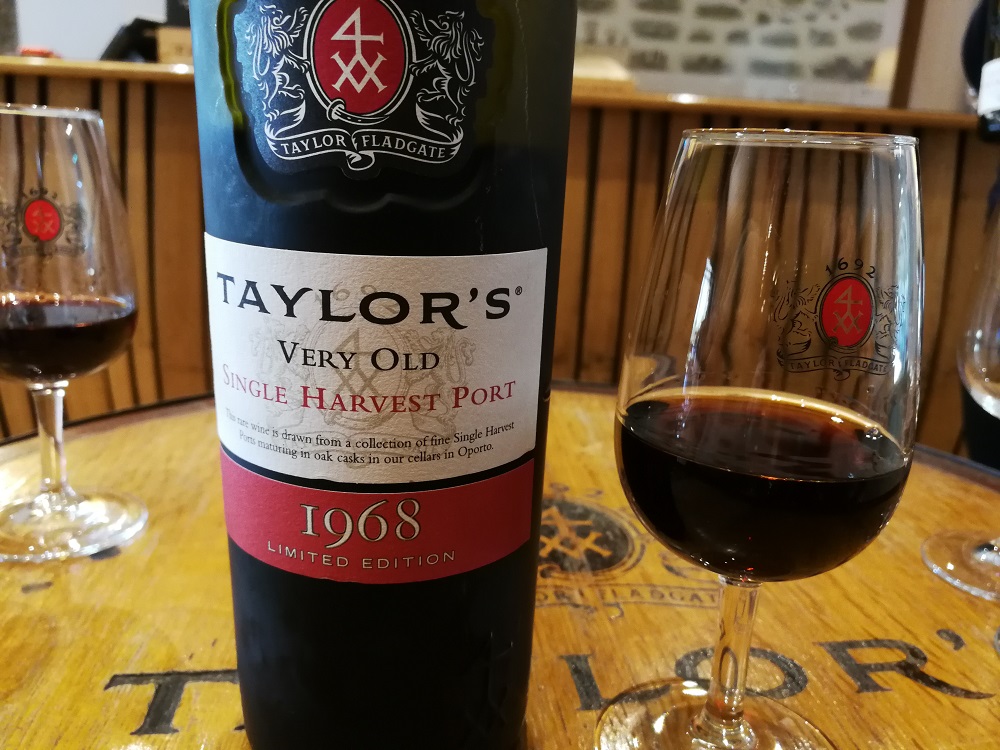
We walked across the impressive Dom Luís I Bridge to Vila Nova de Gaia which is where you’ll find all the wine cellars that tauntingly face Porto. They are literally everywhere! But most of them require a reservation. We knew that Taylor’s is one of the cellars that offers daily self-guided tours. I highly recommend this, as we learned so much about Port wine and enjoyed some samples in the tasting room. After the tour, we splurged (because it was our honeymoon, after all) on a glass of 1968 single harvest Port. Ah-mazing.
Vinho Verde

We may have splurged on Port, but wine in Portugal is generally quite affordable. (It’s also one of the best wines we can find at home in terms of quality/price, so we drink it almost exclusively now). Vinho Verde (“green wine”) is a young wine, released 3-6 months after harvest. It isn’t a varietal, but refers to the region of Northern Portugal where it is traditionally made.
We enjoyed a couple glasses of this acidic, fruity, slightly effervescent wine on the scenic, sunny waterfront. It remains one of our best memories of romantic Porto.
Cheese and Olives
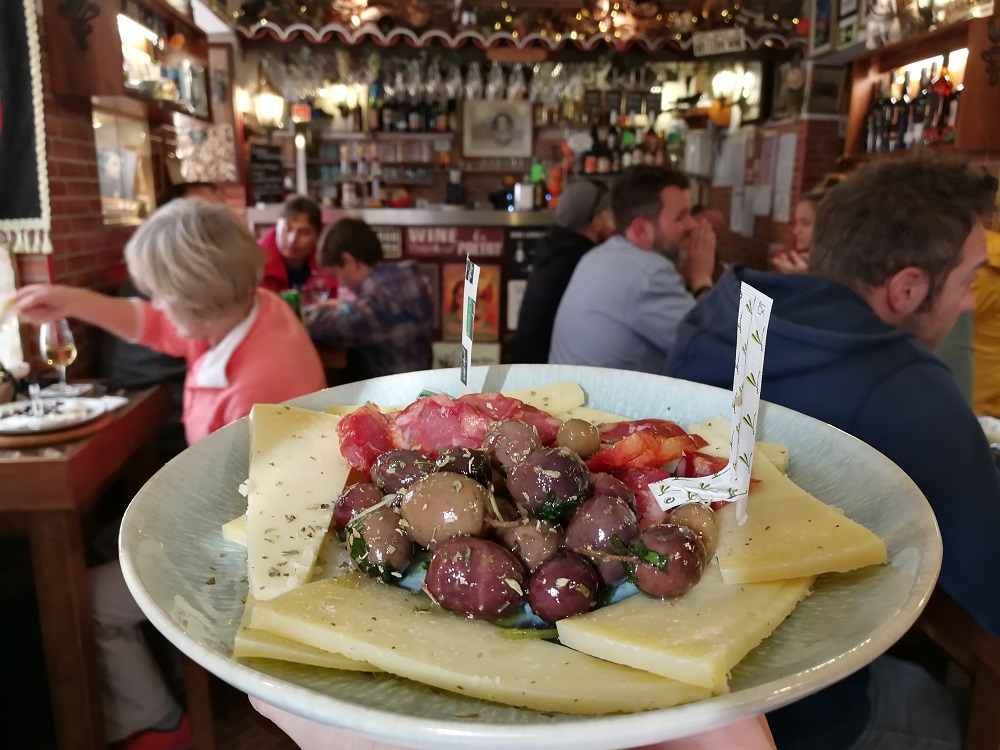
Cheese, olives and chouriço at Cantinho do Lord Byron in Sintra
If The Side Dish had her way, every one of our meals would be cheese, olives and bread. These items are ubiquitous in Portugal and we wholeheartedly enjoyed them on a routine basis. I couldn’t even tell you what type of cheese we were eating half the time, only that it was usually sheep-based and came in a wrapped round. This particular photo was taken at the Cantinho do Lord Byron in Sintra. (Apparently Lord Byron spent some of his formative years in Lisbon). Sintra, which is 40 minutes by train from Lisbon, is a popular day trip spot for tourists largely due to its incredible castles.
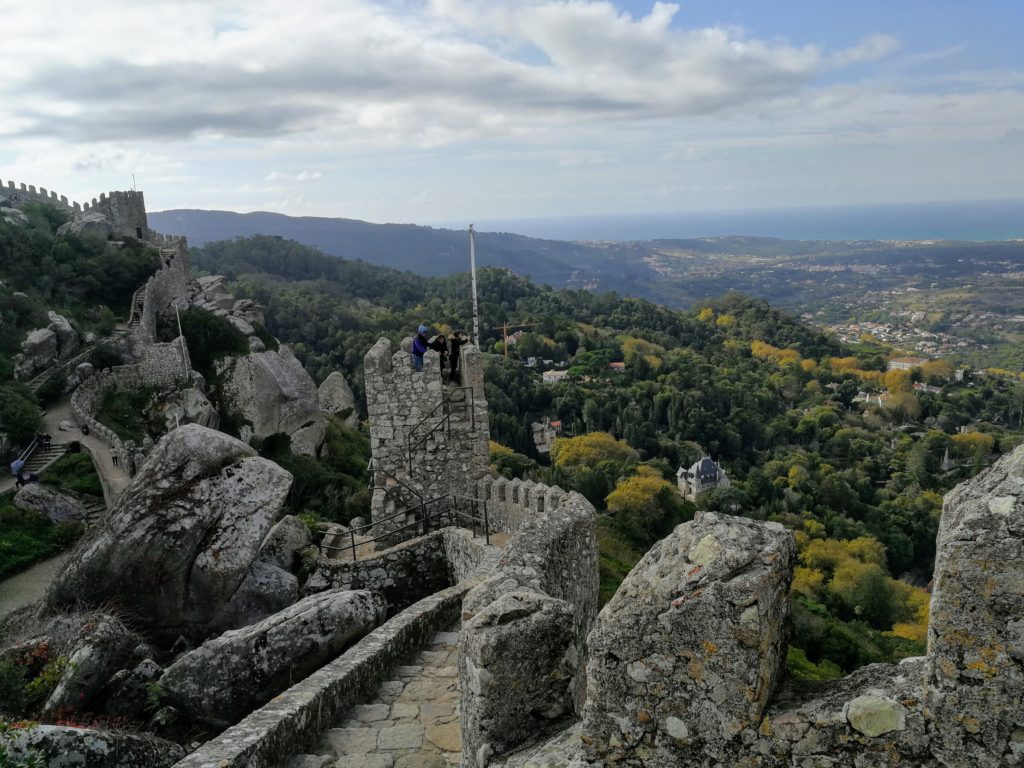
Castelo dos Mouros in Sintra
We had done a lot of climbing to get to the top of the Moorish Castle and we clambered back into town, exhausted and ravenous but also wary of tourist traps. We took a chance on this cozy looking spot, which happily served very large beers in ice cold metal mugs. We left nourished, victorious and ready to hit the touristy streets.
Cozido (Portuguese Boiled Dinner)
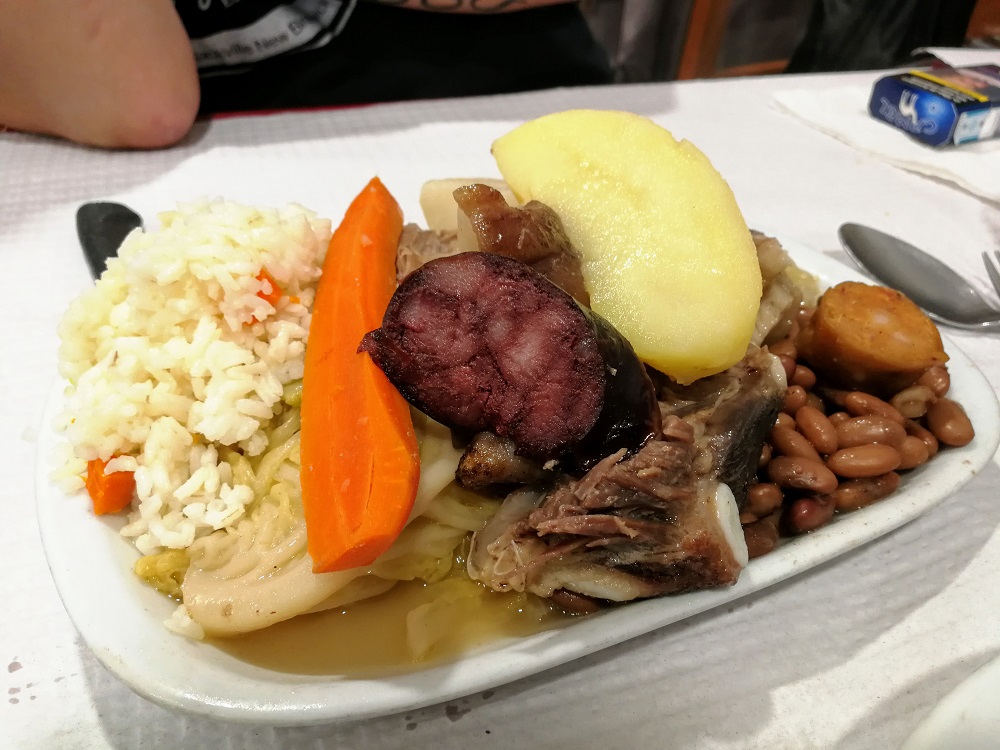
Cozido at Super Mario in Lisbon
When I was researching where to eat in Lisbon, I came across a thread on Reddit where someone recommended a place called Super Mario. They said it was “very Lisbon”, a locals’ spot tucked away from the busy squares of beckoning waiters. It was kind of like a diner, with traditional Portuguese food and beer on tap. There was no English menu, and our server had to grab another employee who spoke better English (we rarely came across anyone in Portugal, even panhandlers, who couldn’t speak English, so perhaps this was a good sign). We indicated that we wanted what was good that day, and he pointed to a couple things on the menu and we just went for it!
Cozido is a Portuguese stew of sausages, blood pudding, various on-the-bone pork meats, beans, cabbage, potatoes, carrots, turnips and rice. It was so flavourful, comforting, and engaging, with so many tidbits to explore.
Fried Sardines
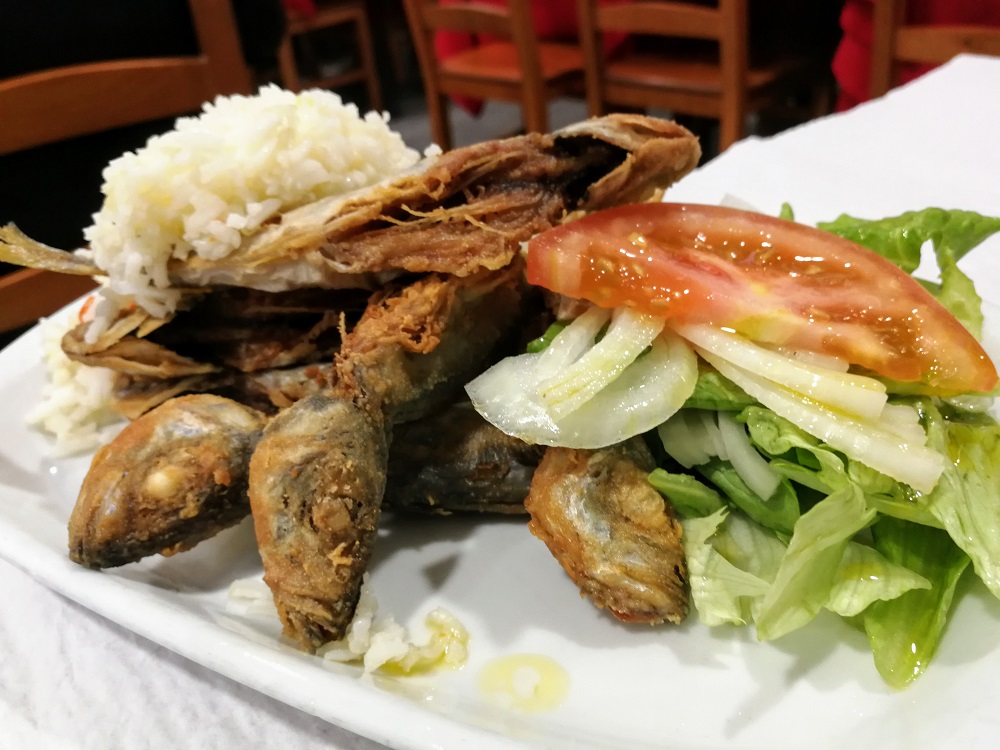
Fried Sardines at Super Mario in Lisbon
The other dish we ordered at Super Mario was fried sardines, (I’m assuming they were sardines, but nobody knew the English translation at the time). The were crispy and super delicious. I even got The Side Dish to eat the head off one of them (that’s the best part, FYI). Combined with the cozido (above), this made for one of our best meals in Portugal!
After we ate we were asked if we wanted coffee, as is the custom, but we weren’t in the mood. If you don’t drink coffee (which is always espresso – even at McDonald’s – which I absolutely love) after your meals in Portugal you’ll be given a funny look. Our hospitable server decided we needed something to finish off our meal, so he provided us with two shots of ginjinha. We left with big smiles and over-stuffed bellies.
Ginjinha
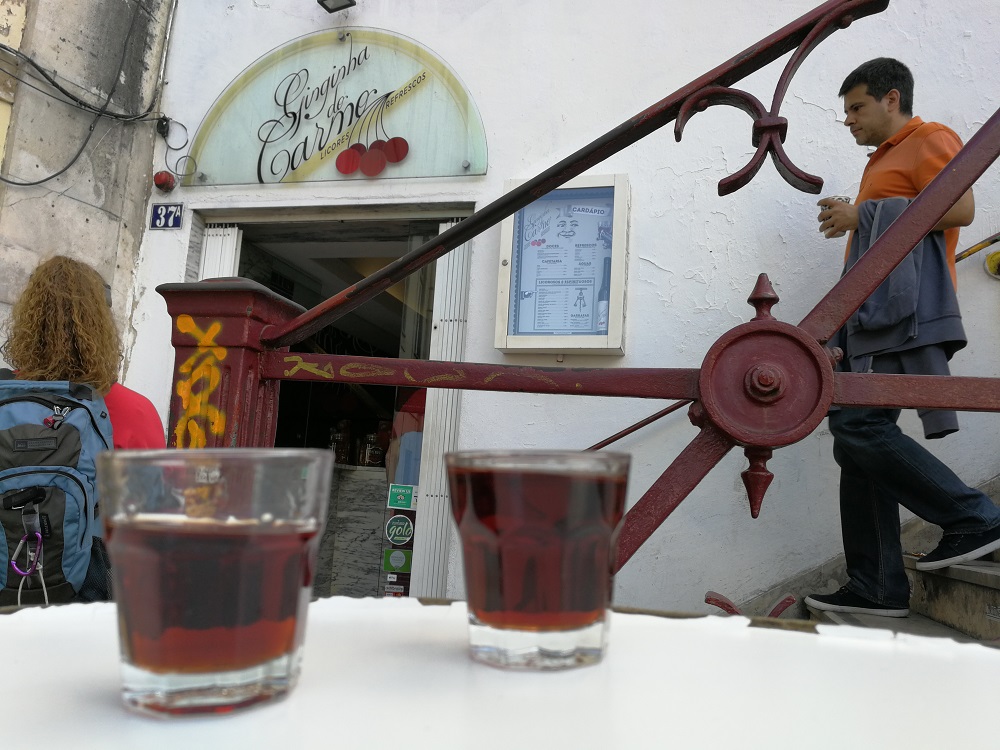
Ginginha do Carmo in Lisbon
So ginjinha is this liquor made from sour morello cherries, and it was considered a “cure all” drink by generations of Portuguese. Ginjinha bars are standing room only – actually, you’ll notice people drinking it on the street, either in small glasses or chocolate cups (if you’re a tourist), with or without booze-soaked cherries. It originates from Óbidos, a medieval town to the north of Lisbon, and is very popular in the nation’s capital, with ginjinha bars opening as early as 9am. I simply couldn’t walk past one without enjoying a glass. For health purposes!
Tinned Sardines
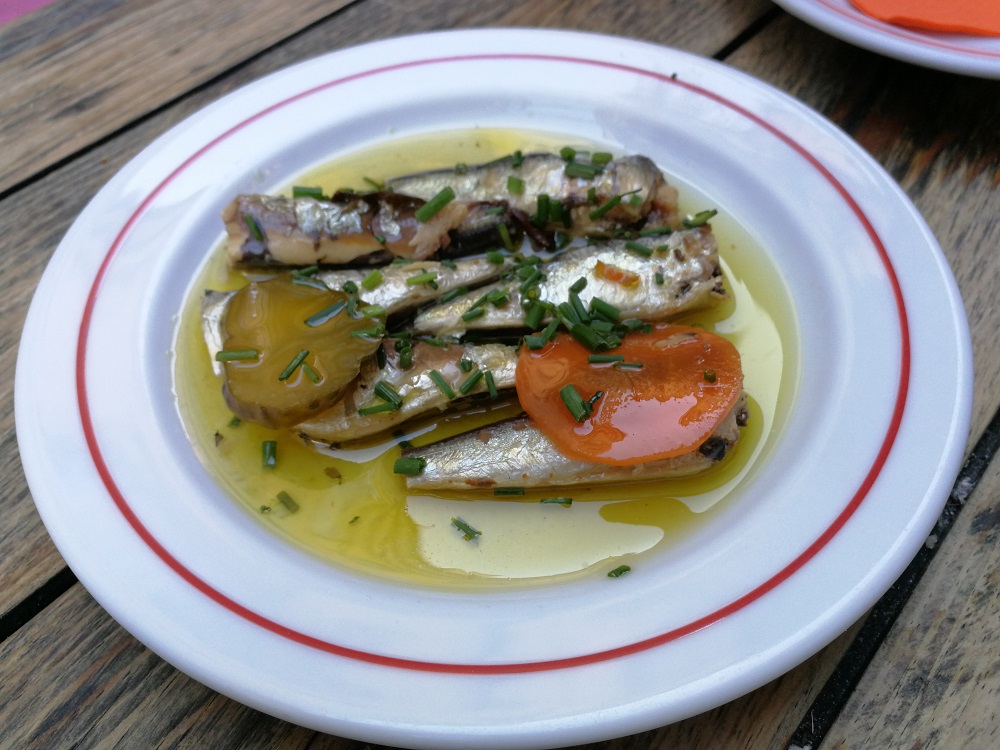
Tinned sardines at Sol e Pesca in Lisbon
You can’t talk about Portuguese food without mentioning tinned seafood, which the Portuguese take very seriously. This is not low quality fare. It is actually considered an appropriate snack for a wine bar, and you will find everything from the famous sardines to tins of octopus, and shops lined wall to wall with different brands, varieties and flavours.
We decided to check out the low-key, Sol e Pesca, which is located on Lisbon’s famous Pink Street. The knowledgeable staff helped us pick out a nice tin of sardines and served it to us lovingly drenched in olive oil and served with bread. Don’t knock it. You gotta try it.
Pastries
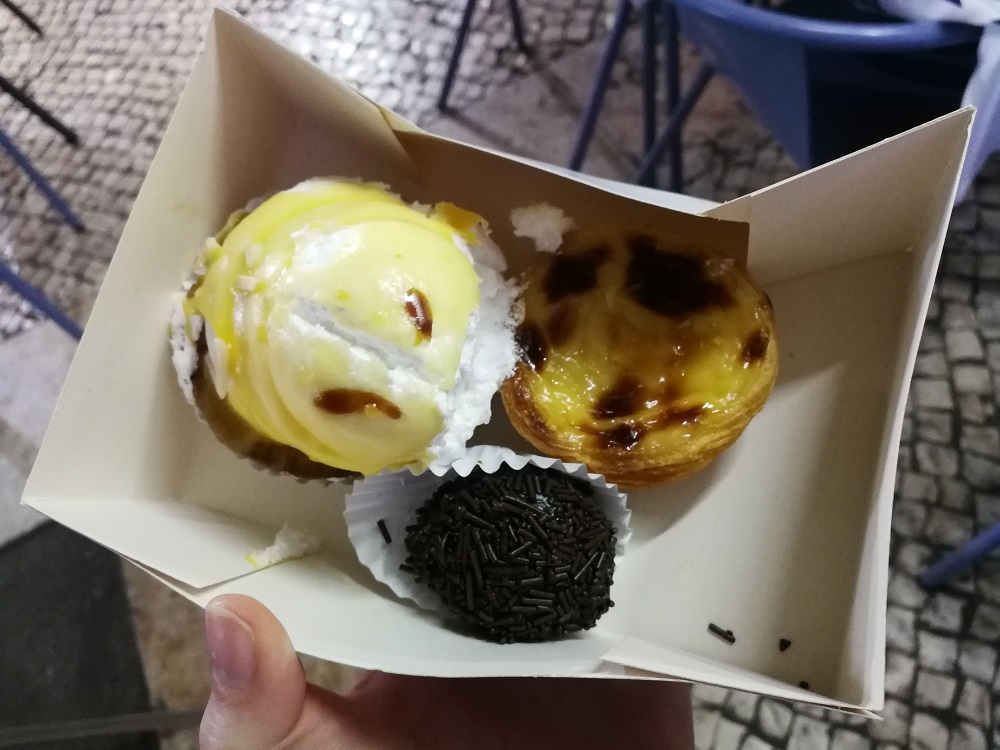
Pastries from Confeitaria Nacional: Portuguese egg tart, Brazilian brigadeiro and some sort of meringue tart.
Breads and pastries are no joke in Portugal – NO JOKE, I say! You are probably familiar with the famous egg tarts (Pastéis de Nata) and you should eat as many of these as possible. But there are so many varieties of pastry and so many pastry shops, it is easy to get overwhelmed.
We walked past the busy Confeitaria Nacional many times before we finally decided to go for it. The Side Dish was excited to see brigadeiros, which are a Brazilian confection of condensed milk, cocoa powder, butter, and chocolate sprinkles. (One thing that surprised me about Portugal was the admiration they have for their South American colony. We encountered lots of Brazilians and drank lots of caipirinhas.)
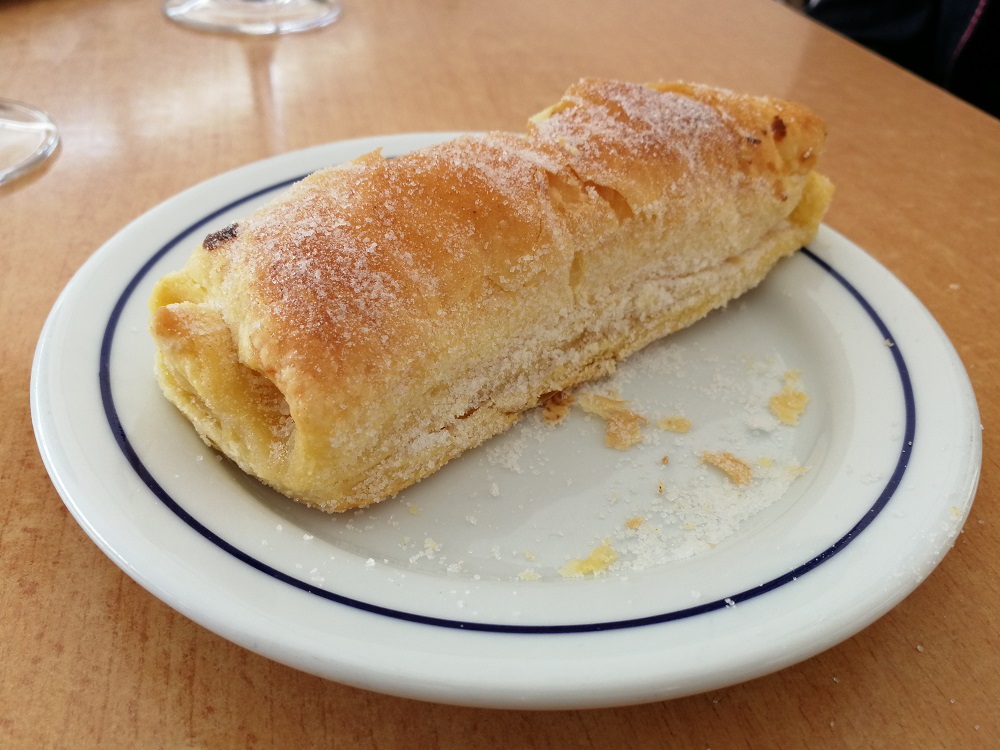
Travesseiro de Sintra at Piriquita II in Sintra
Another pastry I just had to try was Travesseiro de Sintra (Sintra’s pillows), which are a signature pastry of Sintra, with puff pastry and almond cream. You’ll find them at Casa Piriquita, a local landmark since 1862. It was actually closed the day we were there, but fortunately there is a Piriquita II and were were able to enjoy this wonderful snack before heading back to Lisbon.
As for the very best Portuguese egg tart that I tried, it was actually in a little pastry shop next to our Airbnb in Lisbon called Cantinho 75.
Flaming Chouriço

Flaming chouriço at Sentido Proibido in Lisbon
Chouriço (similar to Spanish chorizo) is a smoked sausage that finds its way into many Portuguese dishes, but perhaps the pièce de résistance is chouriço à bombeiro for which the sausage is doused in alcohol and set aflame tableside.
It is a popular snack in fado bars (fado is traditional, melancholic Portuguese music) and I was told that a good spot for both was Tasca do Chico. Unfortunately, the line-up was incredibly long. Lisbon’s Bairro Alto neighbourhood is quite touristy, and fado bars are popular with tourists. We allowed ourselves to be hustled into a fado bar called Sentido Proibido which has scathing reviews on Trip Adviser, but we thoroughly enjoyed the fado and chouriço there.
The Side Dish was moved to tears (by the fado, of course, not the food) and the bellowing, soulful singer came up and gave her a big hug. We did end up going to Tasca do Chico afterwards, sharing a table with a friendly French couple, but the fado and chouriço weren’t as good. I guess you just never know…
Bifana and Prego Sandwiches
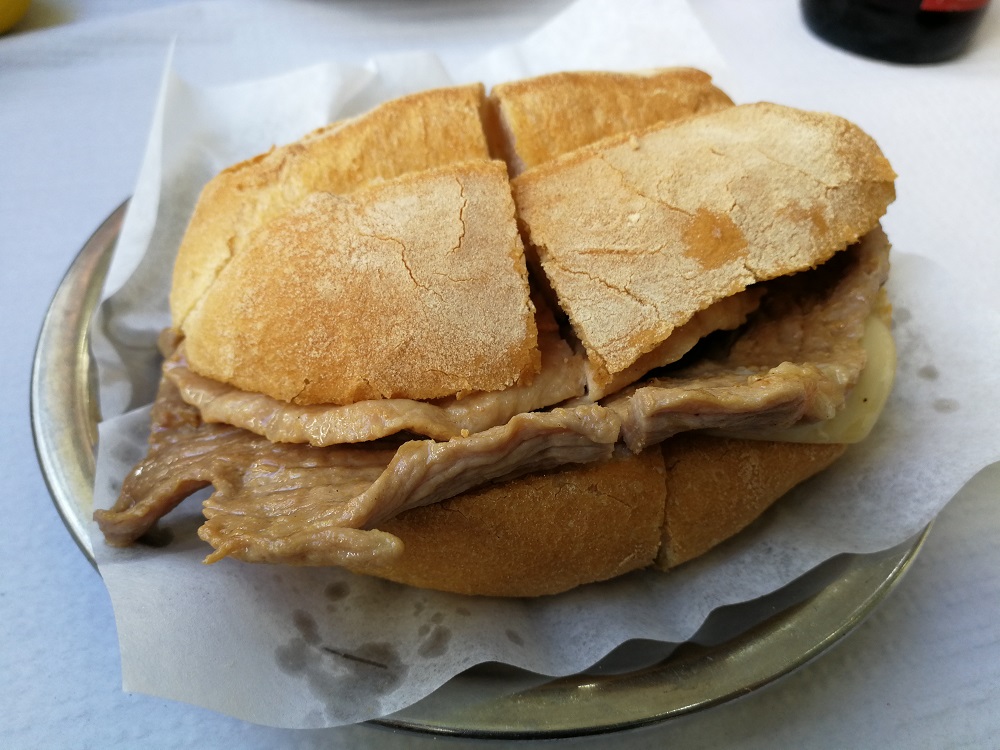
Prego Sandwich at O Trevo in Lisbon
These “national sandwiches” are my new Portuguese food obsession. The Side Dish and I have even tried replicating these at home. They are simple sandwiches of thinly pounded, marinated meat (pork or beef) grilled up and served in a crusty bread roll (papo seco).
The bifana (pork) is the most popular. It’s a great snack to have with a beer, plunked down for a rest, while, in my case, exploring the beautiful city of Lisbon. You can add Portuguese mustard (which contains sugar and wine, unlike conventional American mustard) and/or piri piri sauce.
Prego (the beef version) means “nail”, which refers to the slivers of garlic that are pounded into the beef before grilling. Like the bifana, it is a great snack with a beer, but the prego is also considered a “dessert” after a big feed of shellfish.
I wanted to find the very best bifana sandwich in Lisbon, so I followed in the footsteps of Anthony Bourdain and ventured into O Trevo.
Pastéis de Bacalhau (Salt Cod Fritters)
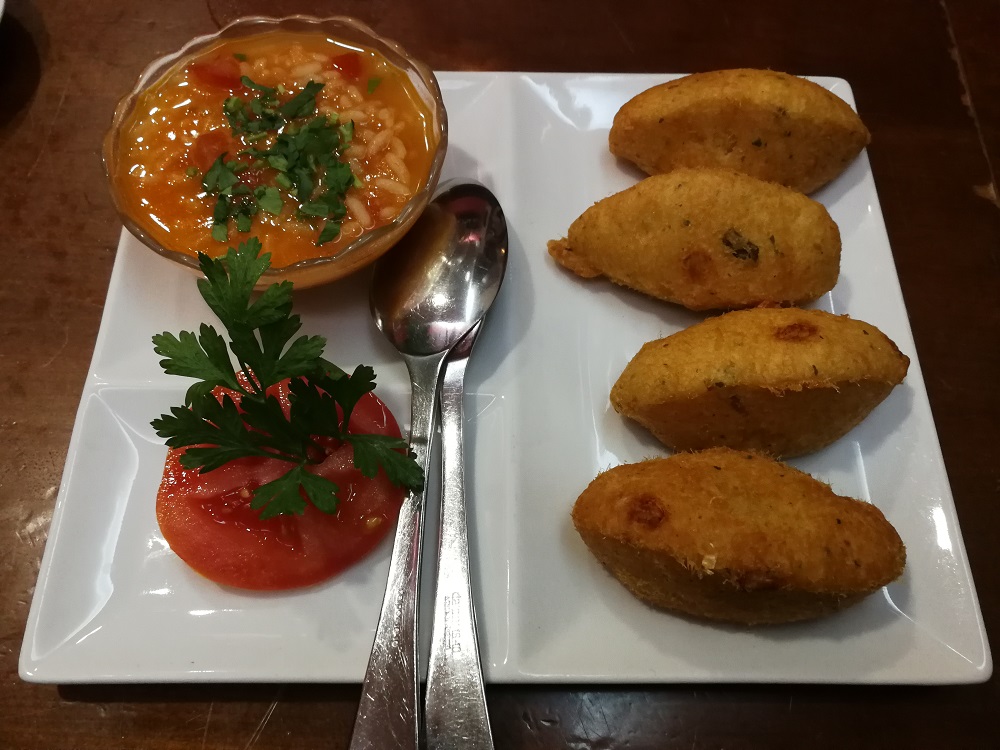
Salt cod fritters at Restaurante Alfaia in Lisbon
There are many preparations of salt cod in Portugal, but perhaps the most ubiquitous are pastéis de bacalhau (salt cod fritters). They are a croquette of mashed potatoes, salt cod, eggs, and parsley that is deep fried. They can be served cold (you’ll see them in pastry shops, bus stations, cafes, etc.) or hot, usually with tomato rice. We enjoyed these at Restaurante Alfaia on our last night in Lisbon, a wine bar with traditional fare.
Migas
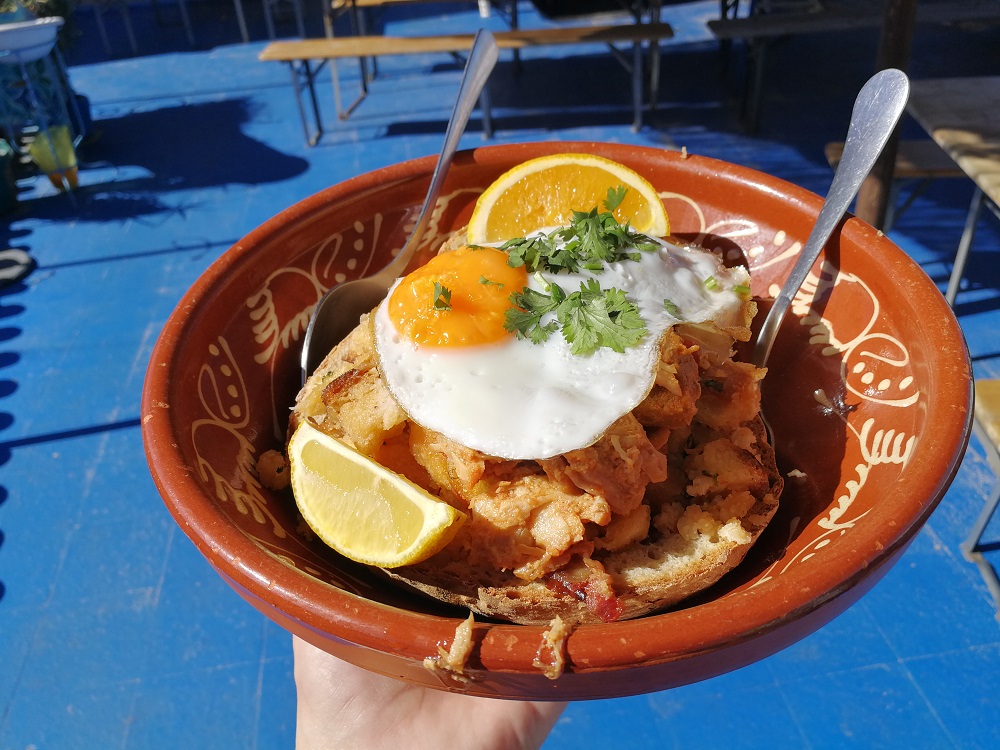
Migas at O Melidense in Melides
Essentially this is stale bread cooked in fat, and flavoured with garlic and olive oil. Depending on the region, a variety of meats, beans and veggies may be added. There are also versions using corn bread or potatoes.
I was in Melides, a beach town in the Alentejo region. I randomly picked a town for lunch, as we drove south along the coast. It was a small, quiet town (at least, in October) and we wandered toward the sound of music, hoping this was an indication of some excitement in the sleepy village. The music led us towards a restaurant called O Melidense, that had an attractive roof top patio, kitschy interior, and a personable owner.
The migas was served in a bread bowl, with a fried egg on top. Orange wedges were provided, which I guessed were for drizzling. The result was quite pleasant, if not exactly summertime fare. It reminded me of turkey stuffing, except with lovely bits of pork scattered around.
Cataplana
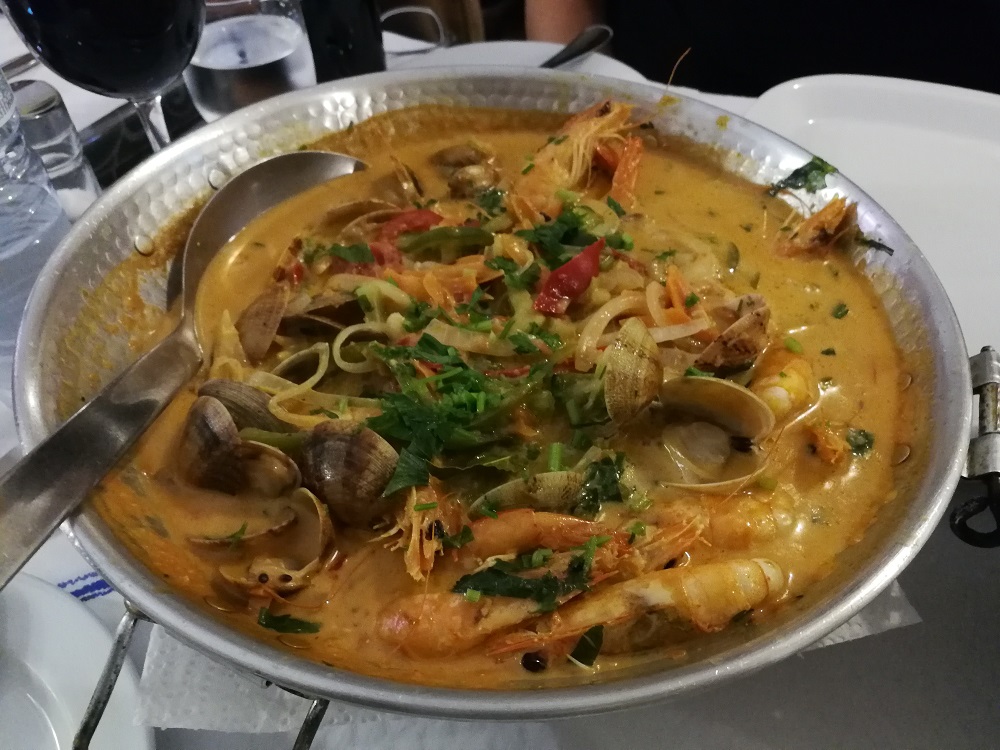
Cataplana at Casinha do Petisco in Lagos
We settled for the night in Lagos, which is, evidently, a bustling coastal tourist town in the summer, but sparse and highly discounted in October.
I learned that a specialty of the Algarve region is cataplana, which is both the name of the dish and the cookware (sort of a copper dome that traps in the steam). A quick Google search painted a clear picture that the best place to enjoy said dish is Casinha do Petisco. Celebrated by both tourists-in-the-know and locals alike, this is a very busy spot and you should make a reservation. We were operating on-the-fly and were told at the door to expect an hour’s wait. They didn’t take our names, but recognized us when we returned in an hour, allowing us to bypass the growing crowd of international Karens demanding to be seated.
It was worth the wait and uncertainty. A huge bowl of seafood stew arrived, full of prawns and clams, and served with sides of potatoes and rice. The broth was one of the most flavourful I have had in my life, and I only wish I knew how to recreate it at home.
Piri Piri Chicken
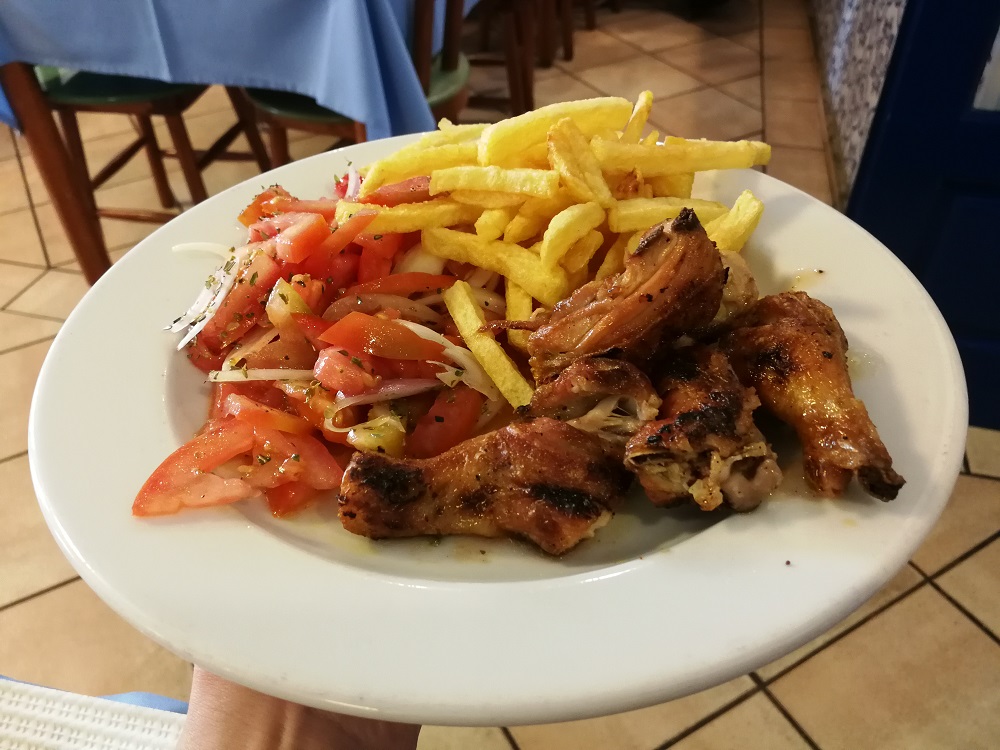
Piri Piri Chicken at Ramires in Guia
A Portuguese food you may be more familiar with is piri-piri chicken. Piri-piri refers to the malagueta pepper which was introduced to Portugal from its African colonies, Angola and Mozambique (piri piri comes from the word for “pepper”). In Portugal, the word generally refers to a sauce with red wine vinegar, paprika, garlic and olive oil accompanying the chili. You’ll see it on table tops as a seasoning sauce, and you’ll taste it in marinated meats.
One such dish is the famous piri piri chicken, sold in churrascarias (BBQ restaurants) across Portugal. You’ll see chicken cooking over charcoal everywhere in Portugal, but frango de churrasco is a speciality of the Algarve region, originating in the city of Guia.

Kayaking in sea caves on the Algarve coast
We had stayed the night in Lagos, spent the morning kayaking to the Benagil Sea Cave, and were now on our way to Spain. Guia just happened to be the ideal spot to stop for lunch, so we found our way to Ramires, which claims to be the first restaurant in Portugal to serve piri piri chicken in 1964.
I don’t know if Ramires serves anything but chicken and I don’t care. We plunked down at a table and the waiter simply asked: “You are here for the chicken?” We just nodded, and shortly thereafter we were presented with three plates: French fries, a simple salad of tomatoes and onions, and the most tantalizing plate of chicken ever set before my eyes.
This is exactly what I love about Portuguese cuisine: perfection in simplicity.
Black Pork
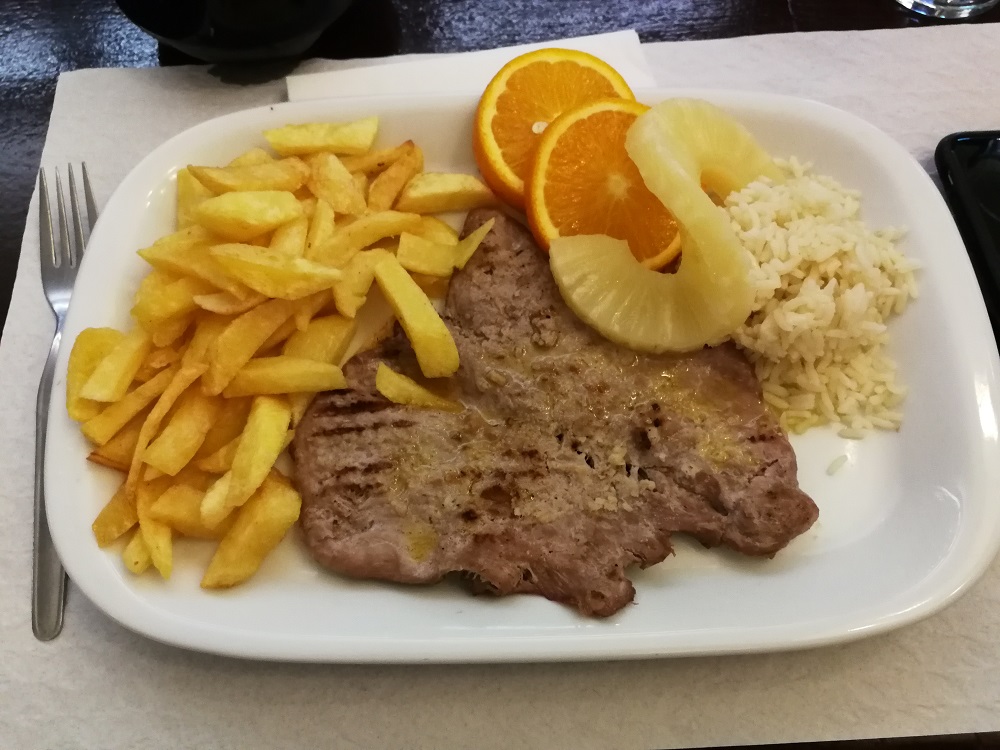
Black Pork at A Choupana in Evora
The last town we visited in Portugal was Évora, a medieval walled town in the interior of the Alentejo, known for its Chapel of Bones. This is a popular day trip destination from Lisbon, right in the middle of the Alentejo wine (and olive oil) country. We had a great experience at the Vinos do Alentejo Tasting Room, which is a good launching point for any wine tourist.
Évora is also know for its cork production, and the acorns that fall from the oak trees have traditionally fed the famous porco preto (black pigs) which are allowed to roam freely in the countryside. These are the same pigs used to make Iberico ham, the famous cured meat of Spain.
The Alentejo cuisine in Évora is distinct from coastal Portugal, and there were many dishes I wanted to try, but black pork was a must. The restaurant I wanted to go to, Taberna Tibica Quarta Feira, known for its fixed price dinners of local delights, was full to capacity. Our hotel manager saw that I was disappointed, and recommended we go to his favourite spot: A Choupana. We sat at the bar, made friends with the bartender, and enjoyed a delicious feed of black pork. Flavourful and meaty, it’s unlike any pork I’ve ever had. We were encouraged to try the sericaia (a very old and traditional Alentejo egg pudding) for dessert.
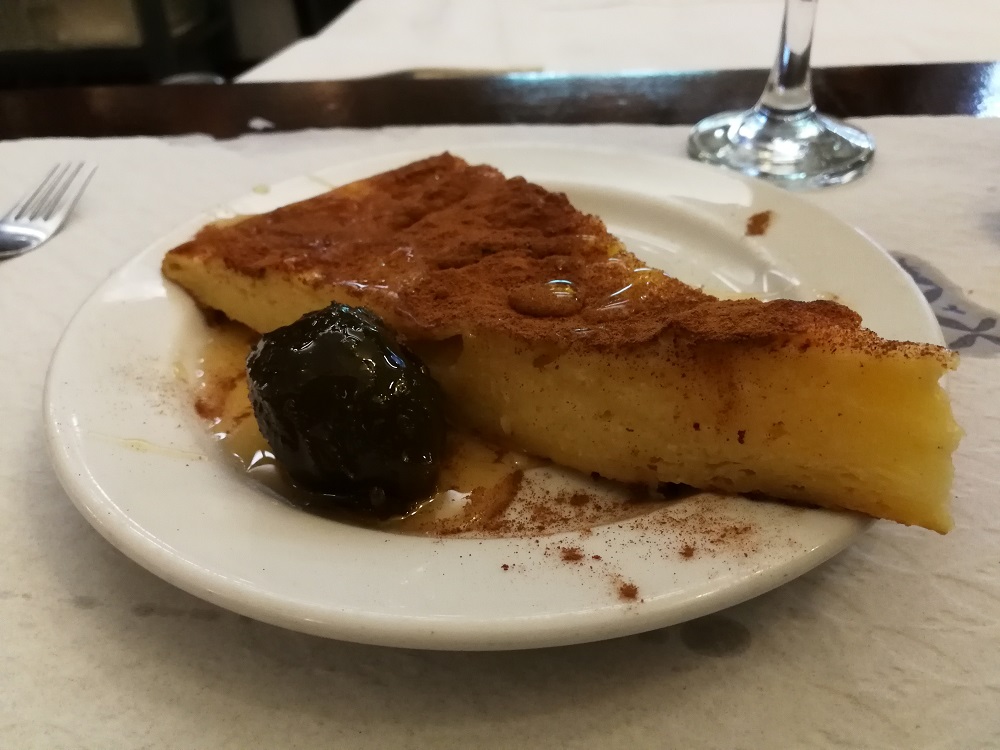
Sericaia at A Choupana in Evora
—
There is so much more to Portuguese food than I could possibly have discovered in a week. It was almost a year ago that I left Portugal, but Portugal hasn’t hasn’t left me. It’s one of those countries that sticks to you, and one short visit will never be enough.
